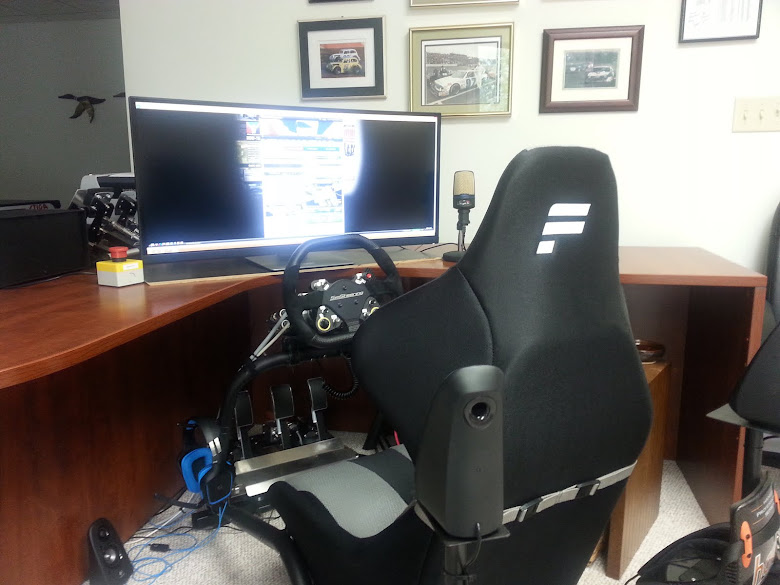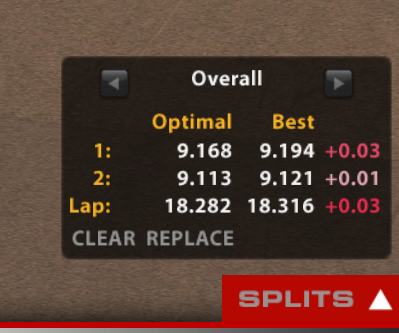Driver Preference:
Camber
Caster
Toe
Differential Setting
Traction Control
In the first two chapters, we covered the "foundation" issues that to a great degree determine the capability of the car.
There are other adjustments that are important, but the way they affect handling to a great degree is determined by driver inputs.
So, let's just review some basics:
We look at the corner in three parts: Corner Entry; Mid-Corner, and Corner Exit.
Corner Entry is where the car is slowed using brakes and/or throttle lift, weight is transferred from the rear to the front tires and the car begins it's "rotation".
This concept of "rotation" is important. To go around a corner, the car needs to have a force on the car's center of gravity (center of mass is the same) toward the inside of the corner, PLUS the car must rotate around it's center of gravity.
The car has inertia that wants the car to go straight. The car also has "polar" inertia that wants to keep from rotating.
To navigate the corner, the "turning" force created by the tires having a slight "slip" must be in "balance" with the front doing as much work as the rear. If the front tires are producing more turning force than the rear, the car will over-rotate and spin in an oversteer condition. If the front tires are producing less turning force than the rear, the car will under-rotate and will seek a larger corner radius in an understeer condition.
Due to "polar" inertia, the car will tend to resist "rotation" during Corner Entry. Often, the driver inputs during Corner Entry introduce "excess rotational momentum" that must be reduced in Mid Corner and/or Corner Exit to avoid oversteer. So, in essence, the driver is controlling the rotation of the car throughout the corner, using different inputs in different corner segments.
Be aware, Ferrari did a masterful engineering feat in the design of this car. The combination of a short wheel base and transverse mid-engine design produced a car with a very low resistance to rotation--a low polar moment of inertia. What this means is that the car response very rapidly to driver inputs--including incorrect ones!
Just for entertainment--view the next video. The Ferrari 488 GTE can be "dirt tracked" or "drifted" around a corner, but this is not the fastest way thru the corner on a paved track.
How the driver introduces the inputs of steering, braking, and throttle modulation during all the corner segments determines to a great degree what settings are best for that driver. How gradually the inputs are applied and the driver's preference for the speed of reaction determines the best settings for him/her.
More experienced drivers will find during their testing that they actually see little difference in lap times when making some setup changes because they adapt and change their inputs to achieve the best outcome. Many times what makes the car faster in corner entry, makes the car slower in corner exit.
Camber
In my Basic Set Up Training for the FR2.0, I went into a great deal of detail. Here, I am going to be more general. The pic below is fascinating in that it is a real car that was built to prove the existence of what we call "camber thrust". The more negative camber--the more cornering force produced by the outside corners--if the tire is rounded. For a wide, rectangular tire, there is a limit.
The Ferrari likes camber in the -2.0 to -3.0 range. Test starting in the middle at -2.5. Changing front and rear can affect the car's understeer/oversteer balance. The limit is usually determined by excess tire temps on the inside edges of the tire. You are essentially trading off the benefits of camber thrust with diminished tire surface as the tire is tilted.
There are two reasons for the negative camber. First is the camber thrust produced. Second is to make up for the amount of camber change that occurs when the chassis rolls. (Some of this camber change is accomplished with unequal A arms, but often not enough, so a bit extra "static" camber is set.
As mentioned, driver preference is important. Higher negative camber tends to make the car a bit more responsive to steering inputs during corner entry but may be counter productive during hard braking and hard acceleration on corner exit.
Caster
Caster is often the least understood setting. Just know this:
Higher positive caster forces the makes the car to rotate faster (more oversteery or less understeery) During a turn, it puts more weight on the inside front an outside rear tires.
On the Ferrari 488 GTE--start with 8.0. A range to consider is 7.0-9.0.
Toe
Tires do not produce cornering force until a slip angle is produced. The orange line in the figure below is a racing slick.
Toe out or negative Toe In on the front tires essentially creates a small initial slip angle on the inside tire that helps the car to feel more responsive to initial turn in and creates a higher slip angle on the inside tire, theoretically increasing overall front tire turning force, within limits.
A slight Toe In on the rear tires creates a slight initial slip angle on the outside rear tire providing more stability under braking and acceleration.
Any setting greater than zero produces drag and reduces top speed to some degree.
Differential
The Ferrari 488GTB has an electronically controlled limited slip differential. The iRacing 488GTE requires us to choose a setting for the number of clutch plates and the spring preload. Unlike other cars, which provide a choice of "ramp" settings, we only choose the number of plates and the preload
More plates=more friction. More preload=more friction. The higher the friction, the more the the inside and outside rear tires are being forced to turn at the same speed--the more like a solid axle. Here is a good video to explain how the system works.
The more friction, the more the car wants to go straight--to resist rotation. Since we are looking to induce rotation and overcome polar inertia in corner entry, you would think you would want low friction. But, alas, during corner entry we are using brakes to slow the car, and when braking and turning at the same time, the inside tire tends to want to lose traction, lock up and cause a spin. So, having more differential friction is like a poor man's anti-lock braking system, helping to keep the inside tire from locking up--allowing more braking while turning--in other words, allowing more aggressive trail braking.
So in essence, the correct choice for the differential setting depends a great deal on how much trail braking the driver prefers and/or uses.
Start at 4/81 and test to 3/44 and 5/125.
Keep in mind that Front Brake Bias will also effect how trail braking influences rotation. Higher diff setting (more friction) will allow less front brake bias--more rear braking power.
Lower diff setting will require a higher front brake bias.
To a great degree, the degree of inducement of "rotation" during corner entry depends to a great degree on driver preference and physical ability to react quickly and accurately. This initial rotation must be slowed at Mid Corner with precise timing or the car will spin. (Always keep in mind that the car will see a brief extra rotation just when brakes are released--as the front tires are then able to devote 100% of tire grip to turning.)
Theoretically, more friction provides more traction during acceleration, so higher diff settings should be beneficial on Corner Exit. Again theoretically, the more friction, the more the car wants to go straight, making the car understeer on Corner Exit. But, in Corner Exit, the inside tire is unloaded and subject to losing traction, so high diff settings can create oversteer on Corner Exit--especially if the rear ARB is relatively stiff. Always test for differential caused oversteer during Corner Exit on tight corners, where full throttle is input early.
Traction Control
There are two settings. One sets the amount of electronic traction control. The second controls the speed that the engine power is reduced.
Start with 2/2 and test 2/3 and other higher settings.
I found with the car properly setup, this feature did not matter as much as I thought it would except in slower first gear corners under hard acceleration.











